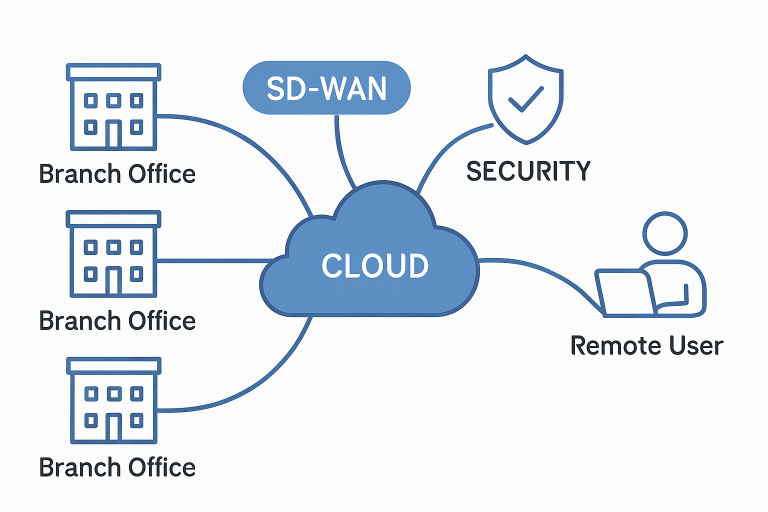Table of Contents
Introduction
As organizations expand and accelerate their digital transformation, the limitations of legacy WAN architectures have become increasingly apparent. The traditional reliance on rigid and costly MPLS circuits often fails to meet modern expectations for agility, cost control, and application performance across distributed enterprises. This shift has triggered a rapid evolution in WAN strategies, pushing businesses to explore solutions that are both flexible and secure.
Today, SD-WAN managed service providers are paving the way for a new generation of WANs, delivering central management, advanced traffic optimization, and dynamic scalability. These service providers help organizations reduce operational overhead while accelerating cloud adoption and improving end-user experience, offering a robust foundation for growth. This new paradigm is fundamentally changing the way enterprises think about connectivity and resilience across locations and remote workforces.
While cost savings and efficiency drive adoption, businesses are also prioritizing security and integration. As data traverses more diverse environments—not just centralized data centers, but branch offices, mobile endpoints, and multiple clouds—a holistic approach to WAN is essential. Leading-edge strategies now merge network optimization with tightly integrated security, automation, and analytics.
To build a future-ready WAN, organizations are embracing not just new technologies, but also new service delivery models. This strategy supports everything from remote collaboration to high-performance cloud applications, meeting the needs of modern IT and hybrid work scenarios in ways that legacy solutions cannot.
Embracing Software-Defined WAN (SD-WAN)
Software-Defined WAN (SD-WAN) has emerged as the linchpin of network modernization. By separating the network control plane from the data plane, SD-WAN solutions enable real-time traffic routing based on application, user, and business priorities. This not only boosts performance over hybrid WAN environments but also slashes operational expenses by allowing the use of broadband and LTE/Mobile links alongside MPLS.
Centralized management empowers IT teams to enforce consistent policies and deploy new sites in minutes rather than weeks. According to eWeek, adoption rates continue to climb as enterprises pursue flexibility and speed. The move towards SD-WAN allows organizations to better align infrastructure with the demands of SaaS, IoT, and multi-cloud strategies.

Integrating Security with SASE
Secure Access Service Edge (SASE) represents a major leap forward, merging WAN and network security into a single, cloud-delivered service framework. SASE integrates firewall-as-a-service (FWaaS), secure web gateways (SWG), cloud access security brokers (CASB), and zero trust network access (ZTNA) to create a cohesive security model regardless of user location.
Such consolidation is crucial for supporting mobile and remote employees, especially in an era where sensitive information moves outside the traditional network perimeter. SASE’s unified policy management ensures seamless protection and compliance for all application traffic. This integration not only enhances security posture but also simplifies the management overhead for IT teams, a point continually emphasized in industry analyses such as those from eWeek.
Leveraging AI and Machine Learning
Artificial Intelligence (AI) and Machine Learning (ML) are transforming WAN operation and management from reactive to predictive. Leveraging AI/ML, network solutions can anticipate congestion, detect anomalies, and proactively reroute traffic before issues disrupt business operations. Automated troubleshooting capabilities shorten resolution times and reduce IT burden, thus improving both user experience and business continuity.
The application of AI in WANs extends to security as well, enhancing threat detection and automated response. A comprehensive study published on arXiv illustrates how these technologies are shaping the architecture and efficiency of next-generation networks.
Adopting Network as a Service (NaaS)
Network as a Service (NaaS) leverages the cloud model’s advantages—scalability, flexibility, and cost-effectiveness—to enhance networking. With NaaS, companies can subscribe to networking features as needed, rapidly scaling up or down without large capital expenditures or long-term commitments. This subscription-based approach is especially attractive for businesses with fluctuating bandwidth or branch expansion plans.
Leading enterprises cite simplicity and agility as primary benefits, as deployment and ongoing management are handled by expert providers. TechTarget highlights how NaaS is increasingly a key option for organizations pursuing multi-cloud networking strategies and dynamic business requirements.
Implementing Hybrid WAN Architectures
Hybrid WAN strategies blend the reliability and quality of service of MPLS with the flexibility and cost savings of broadband internet. This dual-path approach lets organizations assign mission-critical, latency-sensitive applications to MPLS while routing less critical or cloud-bound workloads over broadband, optimizing both cost and performance.
Such architectures offer built-in resiliency and support digital transformation ambitions by accommodating growing application diversity and a globally distributed workforce. This shift is well-detailed in a recent eWeek article that underscores the pivotal role of hybrid solutions in future-ready networking.
Exploring Cloud WAN Solutions
Cloud-native WAN solutions simplify the development, deployment, and scaling of secure global networks. Managed through cloud consoles, these solutions enable seamless integration with cloud services and make it easier to connect users and sites worldwide. With providers like Google offering fully managed Cloud WAN platforms, organizations gain streamlined operations and intrinsic alignment with cloud migration strategies.
The launch of Google Cloud WAN and similar offerings reflects the drive to remove complexity from enterprise networking and empower digital-first operations at scale.
Future Trends in WAN Technologies
The future of WAN lies in greater speed, smarter automation, and fortified security. Next-gen solutions are poised to incorporate quantum-resistant encryption, reducing risk in an increasingly dangerous cyber landscape. Meanwhile, the deployment of 800G Ethernet and network slicing technologies will cater to the bandwidth and agility requirements introduced by AI, IoT, and big data workloads.
Sustainable design principles and the pursuit of carbon-neutral networking will also gain traction.
In summary, modern WAN architectures deliver on the promise of agility, security, and scalability. Organizations that leverage SD-WAN, SASE, NaaS, and cloud-native solutions while embracing AI and hybrid strategies are best positioned to thrive amid constant technological shifts. By staying at the forefront of these advancements, enterprises can ensure reliable digital experiences and be prepared for the network challenges of tomorrow.


